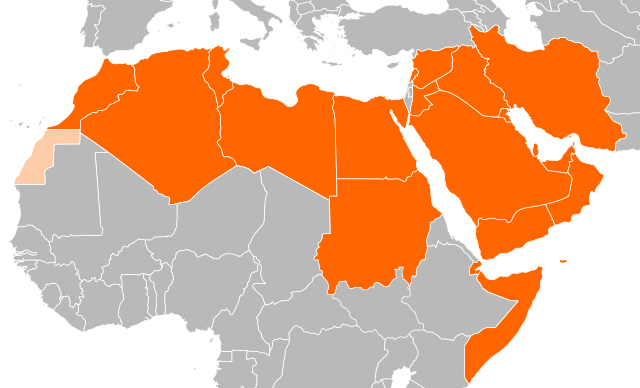MENA vs. SWANA

Map of the MENA region. Photo: Wikimedia Commons
By: Joud Sleilaty / Arab America Contributing Writer
The Origins of the “MENA”/”SWANA” Debate
In the context of geopolitical discussions and cultural classifications, few expressions have sparked as much discourse as “MENA” and “SWANA.” These abbreviations, both indicating the vast territory spanning the Middle East and North Africa, have ignited discussions concerning identity, representation, and precise linguistic distinctions. The question of which term is more accurate goes beyond semantics, diving into the complex history, geography, and the evolving emphasis on political inclusiveness and cultural sensitivity worldwide.
The Origins of “MENA”
The acronym “MENA” stands for Middle East and North Africa. It has been widely used by international organizations, governments, and academic institutions for many years to describe the region stretching from Morocco in the west to Iran in the east. “MENA” became well-recognized due to its simplicity and wide-ranging inclusiveness, representing the interconnected historical, cultural, and economic bonds among the region’s nations. However, the term emerged within a specific historical context, often viewing these countries through a Eurocentric lens, which reflected the political dynamics of the 20th century. Therefore, opponents of the phrase “Middle East” often argue that the term conveys a Eurocentric bias of the region.
The Origins of “SWANA”
“SWANA” stands for Southwest Asia and North Africa. This term emerged as an alternative to rectifying the limitations of “MENA.” Advocates of “SWANA” contend that it provides a more accurate and comprehensive geographical representation. Encompassing countries that are sometimes omitted within the “MENA” framework. The intention is to offer a more precise depiction of the region. While also circumventing the historical baggage associated with the term “Middle East.”
Furthermore, “SWANA” has the added advantage of sidestepping the orientalism and historical weight often connected to the term “Middle East.” It emphasizes geography over colonial influences, promoting a richer understanding of the region’s diversity and shared history. However, critics argue that “SWANA” might not be instantly familiar to a broader audience. It could face challenges in replacing the firmly established use of “MENA.”
The Shift from “MENA” to “SWANA”
However, the shift from “MENA” to “SWANA” is not without challenges. The adoption of new terms requires time for acceptance in various fields. Given the well-established familiarity of “MENA”, it makes it difficult to displace overnight. Moreover, the debate surrounding these terms is intricately tied to political, social, and cultural dimensions. Critics contend that “SWANA” faces issues of representation, particularly in relation to North African countries, which might feel excluded from a label that primarily highlights Southwest Asia. “SWANA” also includes countries with distinct cultural and historical backgrounds from those previously included in the Middle East region. Making it a disapproved term by some locals in the region as well as scholars and governments.
While “MENA” has long been accepted as an acronym for the Middle East and North Africa, its interpretation can notably differ among various organizations and sources. The lack of consistency in identifying MENA’s member nations creates challenges in defining the geographical borders of the region. Conversely, “SWANA,” a relatively newer term. Providing a more distinct framework owing to its direct reference to Southwest Asia and North Africa. This specificity makes it easier to comprehend and recognize the boundaries of the region in question. Although the shift to “SWANA” may encounter obstacles in gaining broad recognition. Its transparent representation of the geographic area could potentially foster a more cohesive comprehension in discussions and discourse.
Where Does the Term “Arab” Fit in the Debate?
The term “Arab” is closely linked to discussions about “MENA” and “SWANA,” pertaining to identity and geography in the regions. It refers to an ethnic and cultural group present across the Middle East, North Africa, and Southwest Asia. While historically rooted, the Arab identity isn’t uniform, with diverse groups like Kurds, Berbers, Persians, and Turks in the regions. Using “Arab” requires sensitivity, as some embrace it while others have complex relationships due to history. The “MENA” vs. “SWANA” debate doesn’t impact “Arab” use, as both acknowledge diverse identities. Respectful discussions require understanding regional dynamics and valuing diverse experiences.
Conclusion
In the end, the choice between “MENA” and “SWANA” is not merely about linguistic preference, but about acknowledging and respecting the identities of the millions of people who call this region home. The conversation surrounding these identity terminologies reflects a broader call for a more inclusive and equitable approach to global discourse. No matter how old language is, it is constantly evolving around the world, to foster understanding and unity, rather than encouraging biases and misconceptions.
Regardless of which term gains dominance, the key lies in using it conscientiously and with a sensitivity to the historical and cultural contexts it encompasses. Instead of getting caught up in the linguistic argument, we should be emphasizing on advancing truthful, considerate, and compassionate conversation that respects the intricate blend of diverse cultures, histories, and aspirations in that region.
Check out Arab America’s blog here!








